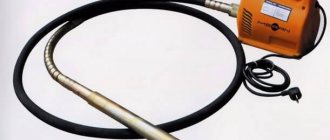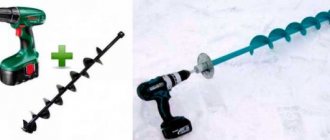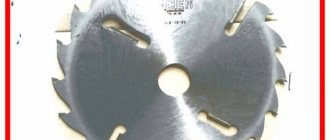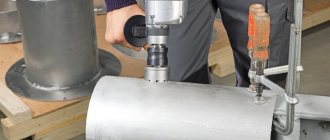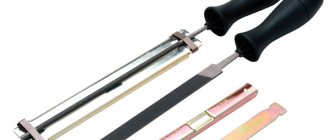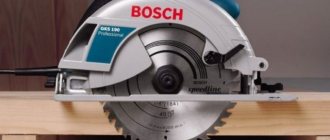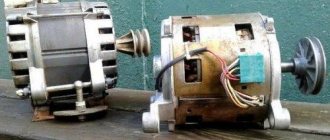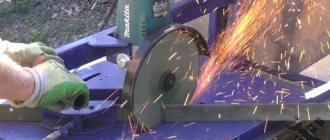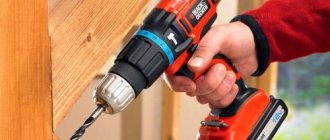Belt grinder: device and principle of operation
There is a tendency to confuse a belt machine with a grinder. A belt sander uses a thin sanding belt rather than a disc to sand surfaces. Thanks to this approach, it is always possible to choose the right abrasiveness and process surfaces of any area.
Tabletop belt grinder with medium abrasive belt Source beltgrinder.ru
The working mechanism is a driving structure on which the abrasive belt is installed. When started, it begins to move due to the activation of the shaft. Next, the surface to be sanded is brought to the abrasive part.
The device of a self-made belt grinder Source forum.guns.ru
The grinder structure contains the following main components:
- a system consisting of several reels. Traditionally, this is one drive shaft and several driven ones;
- bed. It is not present in all machines, but only in those that are supposed to process larger parts (boards, metal surfaces, and others). The frame varies in massiveness: for example, for wood a simple one is used, but for metal parts a powerful one with supports is used;
- tension system. This is a device that allows the tire to remain in tension at all times. If the sanding belt sags, it is very likely to break during startup;
- electrical unit It has a built-in electric motor and assembly. It also usually contains a speed switch, which allows you to regulate the intensity of the belt movement, and as a result, control the process of grinding materials.
Professional equipment is designed with a protective screen that will prevent residual material from getting into a person’s face and eyes. There is also a forced stop mechanism.
Grinder design with a short metal frame Source popgun.ru
Important! For appliances intended for domestic use, it is necessary to consider an exhaust system that will collect waste. In industrial units, this design is provided by the factory.
Areas of application
A grinding grinder is equipment that is very profitable to make yourself, since it can be used to perform a number of technological operations that are associated with grinding parts. As already mentioned, parts can be made based on the following materials:
- tree;
- metal;
- plastic.
A part made in an industrial environment is often not cheap. Also remember that the equipment requires regular maintenance; if necessary, you can repair the belt grinding machine yourself; you do not need special tools or other devices for this.
The belt grinder can be used for the following technological purposes:
- remove flash;
- remove burrs;
- remove minor defects from the surface;
- clean the corrosive layer;
- remove the effects of plasma, laser or other cutting;
- remove defects that were made during the welding process.
Types of grinding machines
Grinder machines are distinguished by power and productivity. For example, models for industrial use perform more complex development steps, while household units are ideal for non-professional sanding of certain building materials at home.
Also, some devices have differences in size, number of revolutions, and width of the working surface of the belt. You need to rely on these parameters when choosing a grinder for specific purposes, and in the case of universal use, it is better to choose options that will ensure high-quality processing of any type of material.
Belt grinder with powerful attachment to the surface Source hammer.su
Belt grinder equipped with a protractor for selecting the angle of inclination Source forum.guns.ru
Selecting a drive for a homemade machine
It is very important to choose the right electric motor to equip your grinding and sharpening equipment. Even if you are assembling a mini-machine, the motor for it should have a power of 1.2–1.5 kW
It is advisable to choose a motor that runs on a 220 V electrical network, because when using a three-phase device and connecting it through a capacitor, you will lose 30 percent of its rated power. In order for your sharpening and grinding machine to be effective, you need to choose an electric motor for it with a high number of revolutions. The drawing of a homemade belt grinder shows that the electric motor for it must be selected with a cantilever type of fastening, which provides for its fixation in the front part of the body.
If you take the time and effort to assemble such a mini-machine, you will be able to work on it in both the horizontal and vertical planes. Such design features of a homemade belt grinder allow it to be used to perform many operations with parts made of metal and any other materials. In addition, you will have at your disposal a very convenient sharpening machine that can be used for the production and sharpening of any cutting tools.
Grinder is a belt grinder. It is intended for dry grinding of various surfaces. It can be wood, artificial stone or plastic. Using this device, you can remove paint, rust, and burrs from metal surfaces. The price of an industrial product is high, so it is better to make a grinder yourself.
Main functions of Grinders
Often, a grinder is used to make small workpieces at home. But its main functions are:
- shaping the edges of knives and other cutting objects;
- removing layers of rust and paint;
- pipe grinding;
- leveling flat surfaces;
- cutting off burrs and defects after uneven trimming.
The simplest machines are designed only for processing the end parts of boards. This machine looks like a compact device with a small frame. The tape on the shafts is installed vertically.
Belt grinder with a convenient stand for sharpening knives Source beltgrinder.ru
How to choose a grinder for your home
It is necessary to choose a grinder model taking into account what type of material needs to be processed. For example, convex or flat surfaces must be “finished” using tape machines specially designed for this purpose. In addition, there are several other characteristics to consider.
Power
Modern factory models are manufactured with power from 500 to 1500 W. Device models with maximum ratings from 1200 to 1500 W will not be superfluous if you regularly have to process various types of workpieces. This equipment is suitable for auto mechanics, electricians, installers, and carpenters.
For amateur use there is no point in choosing strong units. 800 W will be enough to clean various parts from time to time. Such grinders are usually installed in personal garages and workshops.
Belt table grinder with a small frame for processing small parts Source drive2.ru
Belt speed
Belt speed is an important factor that is taken into account when choosing a machine. It is customary to divide devices into three groups.
- 200-360 m/min. This speed will be enough to process some small fragments. These devices will help you perform high-quality sanding of wood, metal and plastic, as well as remove layers of paint on the surfaces of pipes and metal profiles. This speed is enough to prepare parts for work that requires high precision.
- 360-500m/min. High-performance units, which are purchased more often for small workshops. Typically, special narrow sanding belts are produced for these grinders. Others don't fit here. Treat any type of surface.
- 500-1000 m/min. This is special purpose equipment. Designed for processing hard-to-reach areas on parts. Traditionally equipped with narrow ribbons.
On a note! In some grinders, it is possible to adjust the width of the pulley and the speed of the shaft. This will allow the devices to perform diverse work.
Weight
This indicator should be taken into account if you plan to constantly process vertical parts and have to hold the device in your hands. For horizontal grinding, the mass can be ignored.
Belt grinder on a massive metal frame Source popgun.ru
Typically, the weight of the installation varies between 2.5-7 kg. Those that are heavier have high power.
Sanding belt size
Sanding belt size is usually related to power and speed parameters. The wider the belt, the slower it should move on the pulleys. Accordingly, the power of the device for a wide belt should be higher.
Typically, belts with a width of 75-76 mm, 100 mm, 115 mm are produced for grinders. Length can be 457 or 533 mm. It turns out that if the tape is longer, then its operation will be longer.
Additional features that a belt grinder can perform
Grinder may have useful additions to functionality, including
- frames designed to determine the exact boundaries of material removal;
- fastenings that will provide a more reliable fixation of the installation for performing complex processing;
- smooth start, which allows you to gradually gain speed, preventing jerks and, as a result, belt rupture;
- simple replacement of equipment, which does not require unscrewing complex mechanisms using wrenches;
- automatic centering. This option is useful in the case of alternate processing of different types of material. It allows you to adjust the movement of the shaft and belt;
- speed maintenance system, which will help when placing a large load on the device.
Sanding grinder with belt tension adjustment Source guns.allzip.org
Types of rollers for grinder
The grinder is a stationary device with an electric drive. The design consists of a frame, a base with mounting holes for installation on a workbench, a group of cantilever-mounted rollers with a sanding belt passed through them, a tension mechanism, a drive, a control panel and a table for fastening the workpiece. For safety, a folding glass made of transparent unbreakable material is used.
The output shaft of the electric motor is connected to the drive roller of the grinder. The rotation from it is automatically transmitted to the rest through a flexible connection. The position of the driven cylinders is adjustable, which allows you to grind surfaces to different depths. The tension mechanism is designed to compensate for tape stretching and possible slippage. It is located on one of the rollers, which is called tension.
Grinder rollers are considered critical parts. They are used to evenly tension the sanding belt and keep it from slipping.
Depending on the purpose they are:
- driven or leading;
- tension;
- slaves.
How to make grinder rollers with your own hands
Preparing videos for the grinder is one of the most labor-intensive stages of work. Most often, four rollers with different sizes are made for a grinding machine - from 70 to 150 mm. Most often, metal is used; in the first case, steel is used; titanium or duralumin are best suited. Moreover, the width of the rollers depends on the size of the sanded belt. Many craftsmen use both metal and wooden structures, the main thing is to ensure the quality of fastening the “barrel” to the working surface.
Drawing of a grinder roller with dimensions
When creating a drawing for making rollers, remember that the rollers should be barrel-shaped, this will ensure that the tape is held. A drawing is a prerequisite for work, because most likely you will have to turn to turners. If you want your device to work efficiently, you should not skimp on this; in addition, you should choose bearings of class 6 and higher.
DIY grinder pulley
The grinder pulley, after the motor itself, is one of the most expensive elements of a grinding machine. The finished part costs at least 2,000 rubles.
You can watch a video on how to make a pulley for a grinder here:
The process of making grinder rollers
Using a circular saw, we cut the multilayer plywood into six rectangular fragments, the long side of which is exactly twice as large as the shorter side. We mark with a pencil using a device for centering square blanks the middle of the halves of rectangular fragments and mark the found centers with a center punch.
We make blind holes for ball bearings on a drilling machine using a Forstner drill.
Then, using a core drill of a larger diameter, we obtain two round disks from each rectangular fragment.
Using a hammer and a piece of multi-layer plywood, we press sealed ball bearings flush into the blind holes.
We make through holes in all disks in the center with a drill with a diameter corresponding to the size of the inner ring of the bearings.
We thread three round disks onto the bolt and washer using glue. We place a wide washer on top and tighten the block with wrenches and leave it until the glue hardens.
Next, unscrew the nut and remove the tightening bolt. Now we have at our disposal three monoblocks with bearings pressed into the outer disks. Using a pendulum saw, we cut three pieces from a plastic pipe of the required diameter, equal in length to the height of monoblocks of three disks made of multi-layer plywood.
We grind the side surfaces of the monoblocks, securing them in the chuck of a drilling machine, first with a roughing file, then with sandpaper, to the inner diameter of the pieces of plastic pipe, controlling the turning with a caliper.
We press the turned monoblocks with bearings at the ends into pieces of plastic pipes, using the tool feed mechanism of the drilling machine as a press. If the process is difficult, lightly sand the side surface of the monoblock with sandpaper.
We remove the bolts and our tension and driven disks are almost ready. Once again we check the pressing of the bearings and, if necessary, seat them. We process the ends of the rollers on a grinder.
Grinder and sharpener: a brief comparison
A belt grinder and a sharpener are analog devices, as they perform almost the same functions. But there are also differences in the quality of processing and design. The grinder has several advantages that a regular sharpening machine cannot boast of. This:
- precise processing geometry;
- simple replacement of abrasive tape;
- versatility of use.
Please note that due to the presence of a shaft and rollers, the tape becomes perfectly level. This makes it possible to more accurately position the workpiece for processing. As a result of cleaning parts, defects, nicks and burrs do not appear (this often happens when processing metal parts with a grinding wheel).
The grinder belt is made from strong sandpaper Source forum.guns.ru
For belt grinders, many belt options are sold with different abrasiveness. Having a whole set of them on the farm, you can perform work of varying complexity.
Grinder for angle grinders - an alternative to a stationary device
The angle grinder device will be a good replacement for a stationary grinder. It can be used for various jobs that require efficiency: for example, sanding parquet parts or tiles, small metal products.
A small sander with an abrasive belt is a good replacement for a stationary device. Consumables are selected individually for the selected mini-grinder model. But, it has a high cost. It’s easier to purchase a ring tape for a stationary machine of the required length, then simply cut it into pieces taking into account the width of the shaft.
